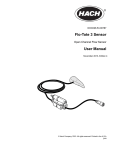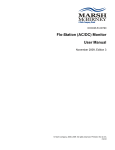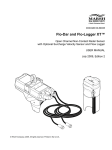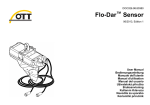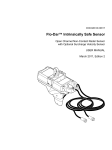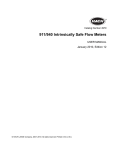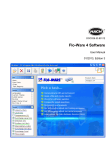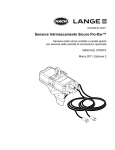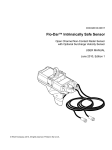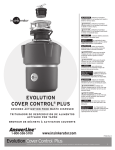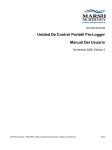Download Flo-Dar™ Sensor - Flowline Manufacturing Ltd
Transcript
DOC026.53.00786 Flo-Dar™ Sensor Open Channel Non-Contact Radar Sensor with Optional Surcharge Velocity Sensor USER MANUAL July 2010, Edition 3 © HACH Company, . All rights reserved. Printed in the U.S.A. Table of contents Section 1 Specifications .................................................................................................................... 3 Section 2 General information ......................................................................................................... 5 2.1 Safety information ........................................................................................................................ 5 2.1.1 Use of hazard information................................................................................................... 5 2.1.2 Precautionary labels ........................................................................................................... 5 2.1.3 Confined space precautions ............................................................................................... 6 2.1.4 FCC regulations .................................................................................................................. 7 2.2 Product overview ......................................................................................................................... 7 2.2.1 Theory of operation............................................................................................................. 8 Section 3 Installation........................................................................................................................ 11 3.1 Unpack the instrument ............................................................................................................... 11 3.2 Mechanical installation............................................................................................................... 12 3.2.1 Site location guidelines ..................................................................................................... 12 3.2.2 Sensor installation............................................................................................................. 14 3.2.2.1 Assemble the clamps on the frame and wall bracket............................................... 17 3.2.2.2 Install the frame on the wall ..................................................................................... 19 3.2.2.3 Install the sensor on the frame................................................................................. 21 3.2.2.4 Align the sensor vertically—Flo-Dar without SVS .................................................... 21 3.2.2.5 Align the sensor vertically—Flo-Dar with SVS ......................................................... 22 3.2.2.6 Align the sensor horizontally .................................................................................... 23 3.2.2.7 Make a final alignment check................................................................................... 24 3.2.2.8 Optional extended depth sensor installation ............................................................ 24 3.2.3 Measure the sensor offset ................................................................................................ 26 3.2.4 Measure the pipe diameter ............................................................................................... 27 3.3 Electrical installation .................................................................................................................. 27 3.3.1 Wiring safety information .................................................................................................. 27 3.3.1.1 Electrostatic Discharge (ESD) considerations ......................................................... 27 3.3.2 Connection to the logger or controller ............................................................................... 28 Section 4 Operation .......................................................................................................................... 29 4.1 Install the Flo-Ware software on the PC .................................................................................... 29 4.2 Set up the FL900 Series Logger, Flo-Logger or Flo-Station ...................................................... 29 Section 5 Maintenance .................................................................................................................... 31 5.1 5.2 5.3 5.4 Preventative maintenance ......................................................................................................... 32 Cleaning the instrument ............................................................................................................. 32 Cable replacement..................................................................................................................... 33 Changing the sensor dessicant.................................................................................................. 33 5.4.1 Desiccant replacement procedure .................................................................................... 33 5.5 Hydrophobic filter description..................................................................................................... 34 5.6 Hydrophobic filter replacement procedure ................................................................................. 35 Section 6 Replacement Parts and Accessories ......................................................................... 37 6.1 Replacement Parts .................................................................................................................... 37 6.2 Accessories................................................................................................................................ 37 Section 7 Contact Information ....................................................................................................... 39 Section 8 Limited warranty ............................................................................................................. 41 1 Table of contents 2 Section 1 Specifications Specifications are subject to change without notice Flo-Dar sensor Dimensions (W x L x D) 160.5 x 432.2 x 297 mm (6.32 x 16.66 x 11.7 in.); with SVS, D=287 mm (15.2 in.) Weight 4.8 kg (10.5 lb) Enclosure IP68 waterproof rating, polystyrene Operating temperature –10 to 50 °C (14 to 122 °F) Storage temperature –40 to 60 °C (–40 to 140 °F) Altitude 4000 m (13,123 ft) maximum Power requirements Supplied by FL900 Series Logger, Flo-Logger or Flo-Station Polyurethane, 0.400 (±0.015) in. diameter Interconnecting cable (disconnect at both sensor and logger ends) IP68 Standard length: 9 m (30 ft); maximum length: 305 m (1000 ft) Method: Ultrasonic Depth measurement Standard operating range from Flo-Dar housing to liquid: 0 to 152.4 cm (0 to 60 in.) Optional extended operating range from transducer face to liquid: 0 to 6.1 m (0 to 20 ft) (with 43.18 cm (17 in.) deadband), temperature compensated Accuracy: ±1% ±0.25 cm (±0.1 in.) Method: Piezo resistive pressure transducer with stainless steel diaphragm Surcharge depth measurement Auto zero function maintains zero error < 0.5 cm (0.2 in.) Range: 3.5 m (138 in.); overpressure rating: 2.5 x full scale Method: Radar Velocity measurement Range: 0.23 m/s to 6.10 m/s (0.75 to 20 ft/s) Frequency Range: 24.075 to 24.175 GHz, 15 mW (EIRP) max. Accuracy: ±0.5%; ±0.03 m/s (±0.1 ft/s) Certification The Flo-Dar Transmitter is certified to the following requirements: - Transmitter type: Field Disturbance Sensor - Frequency: 24.125 GHz - Doppler pulse - Maximum rated power output: 128 dbuV (average) @ 3 meters Certified to: FCC Part 15.245: FCC ID: VIC-FLODAR24 Industry Canada Spec. RSS210. v7: IC No.: 6149A-FLODAR24 Use of this device is subject to the following conditions: 1 There are no used serviceable items inside this device. 2 The user must install this device in accordance with the supplied installation instructions and must not modify the device in any manner whatsoever. 3 Any service involving the transmitter must only be performed by Hach Company. 4 The user must ensure that no one is within 20 cm of the face of the radar transmitter when operating. Flow measurement Method Based on continuity equation Accuracy ± 5% of reading typical where flow is in a channel with uniform flow conditions and is not surcharged, ± 1% full scale max. 3 Specifications Surcharge conditions depth/velocity Depth (standard with Flo-Dar Sensor) Surcharge depth supplied by Flo-Dar sensor Method: Electromagnetic Velocity (with optional surcharge velocity sensor) Range: ±4.8 m/s (±16 ft/s) Accuracy: ±0.15 ft/s or 4% of reading, whichever is greater Zero stability: >±0.05 ft/s FCC and Industry Canada Statements Canadian Interference-causing Equipment Regulation, IECS-003, Class A This Class A digital apparatus meets all requirements of the Canadian Interference-causing Equipment Regulations. Cet appareil numerique de la classe A respecte toutes les exigences du Pegulement sur le materiel brouilleur du Canada FCC PART 15, CLASS "A" Limits The device complies with Part 15 of the FCC Rules. Operation is subject to the following two conditions: 1. This device may not cause harmful interference, and 2. This device must accept any interference received, including interference that may cause undesired operation. Changes or modifications to this unit not expressly approved by the party responsible for compliance could void the user’s authority to operate the equipment. This equipment has been tested and found to comply with the limits for a Class A digital device, pursuant to Part 15 of the FCC Rules. These limits are designated to provide reasonable protection against harmful interference when the equipment is operated in a commercial environment. This equipment generates, uses, and can radiate radio frequency energy and, if not installed and used in accordance with the instruction manual, may cause harmful interference to radio communications. Operation of this equipment in a residential area is likely to cause harmful interference, in which case the user will be required to correct the interference at the user’s own expense. The following techniques of reducing the interference problems are applied easily. 1. Disconnect the equipment from it’s power source to verify that it is or is not the source of the interference. 2. If the equipment is connected into the same outlet as the device with which it is interfering, try another outlet. 3. Move the equipment away from the device receiving the interference. 4. Reposition the receiving antenna for the device receiving the interference. 5. Try combinations of the above. 4 Section 2 General information 2.1 Safety information Please read this entire manual before unpacking, setting up, or operating this equipment. Pay attention to all danger and caution statements. Failure to do so could result in serious injury to the operator or damage to the equipment. To ensure that the protection provided by this equipment is not impaired, do not use or install this equipment in any manner other than that specified in this manual. 2.1.1 Use of hazard information DANGER Indicates a potentially or imminently hazardous situation which, if not avoided, will result in death or serious injury. DANGER Indique une situation de danger potentiel ou imminent qui, si elle n'est pas évitée, peut entraîner la mort ou des blessures graves. WARNING Indicates a potentially or imminently hazardous situation which, if not avoided, could result in death or serious injury. AVERTISSEMENT Indique une situation de danger potentiel ou imminent qui, si elle n'est pas évitée, pourrait entraîner la mort ou des blessures graves. CAUTION Indicates a potentially hazardous situation that may result in minor or moderate injury. ATTENTION Indique une situation potentiellement dangereuse qui peut entraîner des blessures mineures ou modérées. Important Note: Indicates a situation which, if not avoided, may cause damage to the instrument. Information that requires special emphasis. Remarque importante: Indique une situation qui, si elle n'est pas évitée, peut provoquer des dommages à l'appareil. Informations nécessitant une insistance particulière. Note: Information that supplements points in the main text. Remarque : Informations complétant des points du texte principal. 2.1.2 Precautionary labels Read all labels and tags attached to the instrument. Personal injury or damage to the instrument could occur if not observed. This is the safety alert symbol. Obey all safety messages that follow this symbol to avoid potential injury. If on the instrument, refer to the instruction manual for operation or safety information. Ceci est le symbole d'alerte de sécurité. Se conformer à tous les messages de sécurité qui suivent ce symbole afin d'éviter des blessures potentielles. Si apposés sur l'instrument, se référer au manuel d'utilisation pour le fonctionnement ou les informations de sécurité. 5 General information Electrical equipment marked with this symbol may not be disposed of in European public disposal systems after 12 August of 2005. In conformity with European local and national regulations (EU Directive 2002/96/EC), European electrical equipment users must now return old or end-of life equipment to the Producer for disposal at no charge to the user. Note: For return for recycling, please contact the equipment producer or supplier for instructions on how to return end-of-life equipment, producer-supplied electrical accessories, and all auxiliary items for proper disposal. L'équipement électrique marqué de ce symbole ne devra pas être détruit dans les systèmes de destruction publics Européens après le 12 août 2005. En conformité avec les dispositions européennes locales et nationales (Directive EU 2002/96/EC), les utilisateurs européens d'équipements électriques doivent maintenant renvoyer au fabricant pour destruction les équipements anciens ou en fin de vie, sans frais pour l'utilisateur. Remarque : Pour le retour à des fins de recyclage, veuillez contacter le fabricant ou le fournisseur d'équipement pour obtenir les instructions sur la façon de renvoyer l'équipement usagé, les accessoires électriques fournis par le fabricant, et tous les articles auxiliaires pour une mise au rebut appropriée. This symbol, when noted on a product enclosure or barrier, indicates that a risk of electrical shock and/or electrocution exists. Si ce symbole ce trouve sur l’instrument, il indique la présence d’un danger de choc électrique ou d’électrocution. This symbol, when noted on the product, identifies the location of the connection for Protective Earth (ground). Ce symbole, lorsqu’il est apposé sur le produit, indique l’emplacement de la connexion de mise à la terre. This symbol, when noted on the product, identifies the location of a fuse or current limiting device. Lorsque ce symbole se trouve sur un produit, il indique l’emplacement d’un fusible ou autre protection contre les surcharges. This symbol, when noted on the product, indicated the presence of devices sensitive to Electro-static Discharge (ESD) and indicated that care must be taken to prevent damage with the equipment. Ce symbole, s'il figure sur le produit, indiqué la présence des dispositifs sensibles à la décharge électrostatique (ESD) et la nécessité d'agir avec précaution pour éviter d'endommager l'équipement. 2.1.3 Confined space precautions DANGER Explosion hazard. Training in pre-entry testing, ventilation, entry procedures, evacuation/rescue procedures and safety work practices is necessary before entering confined spaces. DANGER Danger d'explosion. Une formation incluant des tests de pré-entrée, la ventilation, les procédures d'entrée, les procédures d'évacuation/de sauvetage et des pratiques de travail de sécurité est nécessaire avant d'entrer dans des espaces restreint. Important Note: The following information is provided to guide users of Flo-Dar Sensors on the dangers and risks associated with entry into confined spaces. Remarque importante : Les informations suivantes sont fournies dans le but d'informer les utilisateurs des capteurs Flo-Dar des dangers et des risques associés à l'accès aux espaces confinés. On April 15, 1993, OSHA’s final ruling on CFR 1910.146, Permit Required Confined Spaces, became law. This new standard directly affects more than 250,000 industrial sites in the U.S.A., and was created to protect the health and safety of workers in confined spaces. 6 General information Definition of a confined space: A confined space is any location or enclosure that presents or has the immediate potential to present one or more of the following conditions: • An atmosphere with less than 19.5% or greater than 23.5% oxygen and/or more than 10 ppm Hydrogen Sulfide (H2S). • An atmosphere that may be flammable or explosive due to gases, vapors, mists, dusts or fibers. • Toxic materials which upon contact or inhalation, could result in injury, impairment of health or death. Confined spaces are not designed for human occupancy. They have restricted entry and contain known or potential hazards. Examples of confined spaces include manholes, stacks, pipes, vats, switch vaults, and other similar locations. Standard safety procedures must always be followed prior to entry into confined spaces and/or locations where hazardous gases, vapors, mists, dusts or fibers may be present. Before entering any confined space check with your employer for procedures related to confined space entry. 2.1.4 FCC regulations Use of this device is subject to the following conditions: • There are no used serviceable items in this device. • The user must install this device in accordance with the supplied installation instructions and must not modify the device in any manner whatsoever. • Any service involving the transmitter must only be performed by Hach Company. • The user must ensure that no one is within 20 cm of the face of the radar transmitter when operating. 2.2 Product overview The Flo-Dar Sensor measures the flow velocity and liquid depth in open channels using radar and ultrasonic technology. The unit is designed to withstand submersion during surcharge conditions. The optional surcharge velocity sensor provides velocity measurements during surcharge conditions. Figure 1 on page 8 shows the configuration of a Flo-Dar system in a non-hazardous location. 7 General information Figure 1 System overview 1 Flo-Dar sensor with optional surcharge velocity sensor 3 Mounting frame 2 Logger or controller 4 Non-hazardous environment 2.2.1 Theory of operation The Flo-Dar Sensor is mounted above an open channel of water and measures the surface velocity and depth from above the surface of the water. The two measurements are used to calculate the flow rate. During surcharge (submerged) conditions, a pressure transducer measures depth. The optional surcharge velocity sensor (SVS) can be used to measure velocity during surcharge conditions. Surface velocity measurement The surface velocity of the water is measured using radar technology. A radar beam is transmitted from the sensor to the water surface at the center of the channel. A portion of the signal is reflected back at a slightly different frequency. The difference in frequency, known as the Doppler frequency, is directly proportional to the speed of the flow. Proprietary algorithms are then used to calculate the average speed of the flow stream. Note: The radar velocity sensor does not operate under surcharge conditions. Velocity measurements during surcharge The optional surcharge velocity sensor (SVS) is activated when the flow level rises to within 7 inches of the sensor mounting frame and remains active until the flow falls to 7 inches below the sensor mounting frame. The mounting frame is installed 5 to 6 inches above the crown of the pipe. This places the velocity-sensing electrodes at the correct location in the flow below the elevation of the crown of the pipe. The SVS measures velocity using an electromagnetic sensor that generates a magnetic field. When the water passes through the magnetic field, a voltage is generated that is directly proportional to the speed of the water passing the sensor. 8 General information Depth measurement The water depth is measured using an ultrasonic pulse echo sensor. An electronic pulse is sent to the water surface and a portion of the signal is returned to the sensor. The transit time to the surface and back is used to calculate the distance from the water surface to the sensor. The pipe diameter is used to convert the distance to water depth. The depth sensor on the Flo-Dar unit can measure distances up to 1.5 m (5 ft). For larger channels, an extended range sensor is available to measure up to 6.1 m (20 ft). During surcharge conditions, a pressure transducer in the Flo-Dar unit is used to measure depth. Flow calculations The velocity and depth measurements are used with the pipe diameter to determine the flow rate. The flow rate is calculated from the continuity equation (1): (1) Flow rate = Average velocity × Area where Flow rate = volume of liquid that passes the sensor per unit time (e.g. 200 gallons per minute) Average velocity = average velocity of the liquid, calculated using surface velocity measurements and algorithms Area = cross-sectional area of the liquid in the channel, calculated using the channel dimensions and depth measurement. 9 General information 10 Section 3 Installation DANGER Explosion hazard. Trained personnel only must install or commission the equipment. DANGER Danger d’explosion. Seul le personnel formé est autoriséà installer ou à mettre en service l’équipement. 3.1 Unpack the instrument The instrument components with options are shown in Figure 2. Figure 2 Instrument components 1 Surcharge velocity sensor (SVS) (optional) 10 Clamp bolt, ¼-20 x 1 in. (8x) 2 Flo-Dar sensor 11 Anchor nut, 3/8-16 (2x) 3 Optional extended depth sensor 12 Anchor washer (2x) 4 Bubble level 13 Anchor nut, 3/8 x 2¼ in. (2x) 5 Cable connectors 14 Adjustable wall bracket 6 Spacer, 12-inch 15 Wall mount bracket 7 Spacer, 2¼-inch 16 Standard frame 8 Clamp half, threaded (2x) 17 Frame for extended depth sensor (optional) 9 Clamp half, not threaded (2x) 11 Installation 3.2 Mechanical installation 3.2.1 Site location guidelines For best accuracy, install the sensor where the flow is not turbulent. An ideal location is in a long, straight channel or pipe. Outfalls, vertical drops, baffles, curves or junctions cause the velocity profile to become distorted. Where there are outfalls, vertical drops, baffles, curves or junctions, install the sensor upstream or downstream as shown in Figure 3 and Figure 4. For upstream locations, install the sensor at a distance that is at least five times the pipe diameter or maximum fluid level. For downstream locations, install the sensor at a distance that is at least ten times the pipe diameter or maximum fluid level. If the location contains a junction and the flow in one pipe is much higher, install the sensor on the wall near the lower flow pipe. Figure 3 Sensor location near an outfall, vertical drop or baffle 1 Acceptable upstream sensor location 5 Distance downstream: 10 x pipe diameter 2 Outfall 6 Vertical drop 3 Distance upstream: 5 x maximum level 7 Baffle 4 Acceptable downstream sensor location 12 Installation Figure 4 Sensor location near a curve, elbow or junction 1 Acceptable upstream sensor location 3 Distance downstream: 10 x pipe diameter 2 Acceptable downstream sensor location 4 Distance upstream: 5 x pipe diameter 13 Installation 3.2.2 Sensor installation CAUTION Potential hearing loss risk. Hearing protection required. The level transducer emits ultrasonic sound energy when powered. Ear protection must be worn when working within 1 meter of this device. Do not point the transducer output towards ears during installation, calibration and maintenance. ATTENTION Risque de perte auditive. Protections auditives requises. Une fois activé, le transducteur de niveau émet une énergie ultrasonore. Des protections auditives doivent être portées lors de toute intervention à moins d’un mètre de cet appareil. Ne pointez pas la sortie du transducteur vers des oreilles lors d’opérations d’installation, d’étalonnage et de maintenance. WARNING Explosion hazard. Installation of equipment into hazardous locations must be done so that no friction can be generated between the Flow Meter and any surrounding surfaces (Figure 1 on page 8). ATTENTION Risque d’explosion. L’installation de l’équipement dans des zones dangereuses doit être effectuée de sorte qu’aucun frottement ne soit provoqué entre le débitmètre et toute surface environnante (Figure 1 de la page 8). Mount the Flo-Dar sensor above the open channel on the wall of the manhole. A pole is available for retrieval of the Flo-Dar sensor without entry into the manhole. For temporary installation, an optional Jack-bar is available (see Accessories on page 41). Instructions are included with the Jack-bar. 14 Installation The Flo-Dar sensor dimensions are shown in Figure 5 and Figure 6. Figure 5 Flo-Dar sensor dimensions 1 Optional extended depth sensor 2 Minimum clearance for cable with extended depth sensor 3 Minimum clearance for cable 15 Installation Figure 6 Flo-Dar sensor with SVS dimensions 1 16 Minimum clearance for cable Installation The dimensions of the standard frame for wall installation are shown in Figure 7. Figure 7 Standard frame dimensions 1 22.8 in. with 2¼ in. spacer; 32.6 in. with 12 in. spacer 3.2.2.1 Assemble the clamps on the frame and wall bracket Install the clamps on the frame and wall mount bracket before installation on the wall. Prerequisites • Frame • Wall mount bracket • Clamps • Hardware—wall bracket, spacer, nuts and bolts Procedure 1. Position two clamp halves (one with threads and one without threads) around the wall mount bracket as shown in Figure 8. 2. Connect the clamp halves together with four bolts. Lightly tighten the bolts to temporarily hold the clamp in position. 17 Installation 3. Position the other two clamp halves around the front end of the frame as shown in Figure 8. Note: In most cases the front of the frame will point toward the wall as shown in Figure 8 (see also Figure 12 on page 23). If flow conditions require the sensor to point away from the wall, use the 12-inch spacer and position the two clamp halves around the back end of the frame. 4. Connect the clamp halves together with four bolts. Lightly tighten the bolts to temporarily hold the clamp in position. Figure 8 Clamps assembled on wall bracket and frame 1 Adjustable wall bracket 5 Frame 2 Clamp half, threaded 6 Spacer 3 Clamp bolt, ¼–20 x 1 in. 7 Wall mount bracket 4 Clamp half, not threaded 18 Installation 3.2.2.2 Install the frame on the wall DANGER Explosion hazard. Review the safety information in 2.1.3 Confined space precautions on page 6 before entering a confined space. DANGER Danger d'explosion. Revoyez les informations concernant la sécurité à la section 2.1.3 à la page 8 avant d'entrer dans un espace restreint. Sensor location guidelines Review the following guidelines to find the best location for the sensor. • Examine the upstream and downstream flow characteristics. Use a mirror if necessary. Install the sensor above the water where the flow is steady. Do not install the sensor where there are standing waves, pools or objects or materials that can disrupt the flow profile. • If the upstream flow characteristics are acceptable, install the sensor on the upstream wall of the manhole with the sensor pointing upstream. This location will make sure that the measured flow is the same as the flow in the pipe and that the sensor cable points away from the wall. • Install the sensor away from the sides of the pipe and in the very center of the flow where the fluid is at the maximum depth. • Install the sensor in a location that is accessible for maintenance. Prerequisites • Frame and wall mount bracket assembly (assembled in section 3.2.2.1 on page 17) • Anchors with nuts and washers • Tools: mirror, ruler or tape measure, marker Procedure Complete the steps to install the frame on the wall of the manhole above the flow. Be sure to follow all codes and/or directives that are relevant to the location (refer to 3.2.1 on page 12). 1. Make a mark on the wall that identifies the location of the top of the sensor frame (Figure 9). The wall brackets will be installed above and below this mark. • Flo-Dar without SVS—make sure that when the sensor is in the frame, the radar beam will not be blocked by the wall or channel (Figure 11). • Flo-Dar with SVS—the top of the sensor frame must be installed at an exact distance above the top of the channel. For pipe diameters greater than 25 inches, measure 5 inches from the top of the channel to the top of the frame. For pipe diameters less than 25 inches, measure 6 inches from the top of the channel to the top of the frame. 2. Position the wall mount brackets above and below this mark. 3. Attach the brackets to the wall using the supplied anchors. Install the anchors into 3/8-inch diameter holes at a depth of 1½ inches. 4. Connect the frame to the wall bracket with a spacer as shown in Figure 9. The 12-inch spacer may be necessary to position the sensor farther from the wall when there is a large pipe lip. 19 Installation Figure 9 Wall installation 1 Distance from crown of pipe to top of frame 3 Washer 2 Anchor 4 Nut 20 Installation 3.2.2.3 Install the sensor on the frame The sensor fits in the frame in only one direction and locks in position when the bail on the sensor is turned (Figure 10). The sensor can be removed from the frame and installed without entering the manhole when the optional retrieval pole is used (see Accessories on page 37). Procedure 1. Make sure that the cable is tightly connected to the sensor. 2. Turn the bail to retract the locking bars on the sensor. 3. Position the sensor on the frame. The cable should point toward the center of the manhole. 4. Turn the bail to lock the sensor on the frame (Figure 10). Figure 10 Horizontal alignment 1 Bubble level 2 Bail 3.2.2.4 Align the sensor vertically—Flo-Dar without SVS The sensor must be aligned vertically to make sure that the sensor is above the flow and that the radar beam will not be blocked by the wall or pipe (Figure 11). Procedure 1. Make an estimate of where a line that extends from the top of the radar lens perpendicular to where the lens will point (Figure 11). 2. Loosen the clamp on the wall mount bracket and position the frame so that the radar beam will point below the crown of the pipe by at least 1 inch (Figure 11). It may be necessary to install the 12-inch spacer to extend the frame farther from the wall. 3. Tighten the clamp and measure the frame position. Make sure that the radar beam is not blocked by the wall or pipe. If the beam is blocked, move the frame further away from the wall using the 12-inch spacer or lower the frame. 21 Installation Figure 11 Vertical alignment of Flo-Dar sensor 1 Spacer 2 Distance from crown of pipe to top of frame 3.2.2.5 Align the sensor vertically—Flo-Dar with SVS The sensor must be aligned vertically to make sure that the sensor is above the flow under normal full flow conditions and that the SVS is activated under surcharge conditions. Prerequisites • Ruler or tape measure Procedure 1. Measure directly above the crown of the pipe to the top of the frame (Figure 9 on page 20). 2. If the pipe lip is longer than 5½ inches, install the 12-inch spacer between the wall mount bracket and the frame (Figure 12). 3. Loosen the clamp on the wall mount bracket and position the top of the frame above the crown of the pipe at the specified distance: 22 • 6 inches for a pipe diameter that is less than 24 inches • 5 inches for a pipe diameter that is equal to or larger than 24 inches Installation 4. Tighten the clamp and measure the frame position again to make sure it is at the correct position. Figure 12 Vertical alignment of Flo-Dar sensor with SVS 1 Spacer 3 2 Distance from crown of pipe to top of frame SVS sensor (optional) 3.2.2.6 Align the sensor horizontally The sensor must be aligned horizontally to make sure that the sensor is centered over the flow. If the pipe is not level and has a slope of 2 degrees or more, align the sensor to be parallel with the surface of the water. Prerequisites • Bubble level Procedure 1. Remove the paper backing from the bubble level and attach the level to the sensor (Figure 10 on page 21). 2. Loosen the clamps and tap the frame into position. 3. Tighten both clamps and measure the frame position to make sure it is at the correct position. 23 Installation 3.2.2.7 Make a final alignment check The correct vertical and horizontal alignment of the sensor is necessary for accurate measurements. 1. Measure the vertical alignment (section 3.2.2.4 on page 21 or section 3.2.2.5 on page 22) and make adjustments if necessary. 2. Measure the horizontal alignment (section 3.2.2.6 on page 23) and make adjustments if necessary. 3. Repeat steps 1 and 2 until no further adjustments are necessary. 3.2.2.8 Optional extended depth sensor installation The extended depth sensor (Figure 13) can be used when the pipe or channel depth exceeds the standard level specifications (refer to Specifications on page 3). Use the extended frame (Figure 14) in place of the standard frame, or mount the extended depth sensor on the wall. The extended depth sensor must be installed at least 18 inches above the crown of the pipe for correct measurements. The extended depth sensor has a deadband zone of 17 inches where the sensor is not active. Figure 13 Extended sensor dimensions 24 Installation Figure 14 Extended frame dimensions 1 29.1 in. with 2¼ in. spacer; 38.8 in. with 12 in. spacer Figure 15 Vertical alignment with extended depth sensor 1 Spacer 25 Installation 3.2.3 Measure the sensor offset The sensor offset is the distance from the top of the frame to the bottom of the pipe or channel. This distance will be entered into the software and is necessary for accurate flow calculations. If the extended depth sensor (section 3.2.2.8 on page 24) is installed on the wall without the extended frame, the sensor offset is the distance from the face of the extended depth sensor to the bottom of the pipe or channel. Prerequisites • Rod • Tape measure Procedure 1. Put the rod in the bottom of the pipe or channel and align it vertically with the frame (Figure 16). 2. Make a mark on the rod to identify where the top of the sensor frame is. 3. Measure the distance from the bottom of the rod to the mark. This is the sensor offset. Note: If it is not practical to measure to the bottom of the pipe, measure the distance from the crown of the pipe to the top of the frame (Figure 16). Add this distance to the pipe diameter to get the sensor offset (sensor offset = pipe diameter + distance from crown of the pipe to top of frame). Figure 16 Sensor offset 1 Distance from crown of pipe to top of frame 2 Pipe diameter 26 3 Sensor offset Installation 3.2.4 Measure the pipe diameter The correct diameter of the pipe or channel is necessary for accurate flow calculations. 1. Measure the inside pipe diameter (I.D.) at three locations (Figure 17). Be sure that the measurements are accurate. 2. Calculate the average of the three measurements. Record this number for use during the software setup for the site. Figure 17 Pipe diameter measurement 3.3 Electrical installation 3.3.1 Wiring safety information When making any wiring connections to the instrument, the following warnings and notes must be adhered to, as well as any warnings and notes found throughout the individual installation sections. For more safety information refer to section 2.1 on page 5. CAUTION Always disconnect power to the instrument when making any electrical connections. Attention Débranchez toujours l'alimentation de l'appareil avant toute connexion électrique. 3.3.1.1 Electrostatic Discharge (ESD) considerations Important Note: To minimize hazards and ESD risks, maintenance procedures not requiring power to the instrument should be performed with power removed. Delicate internal electronic components can be damaged by static electricity, resulting in degraded instrument performance or eventual failure. The manufacturer recommends taking the following steps to prevent ESD damage to your instrument: • Before touching any instrument electronic components (such as printed circuit cards and the components on them) discharge static electricity from your body. This can be 27 Installation accomplished by touching an earth-grounded metal surface such as the chassis of an instrument, or a metal conduit or pipe. • To reduce static build-up, avoid excessive movement. Transport static-sensitive components in anti-static containers or packaging. • To discharge static electricity from your body and keep it discharged, wear a wrist strap connected by a wire to earth ground. • Handle all static-sensitive components in a static-safe area. If possible, use anti-static floor pads and work bench pads. 3.3.2 Connection to the logger or controller Connect the cable from the Flo-Dar sensor to the logger or the controller: 28 • Logger–connect the cable from the Flo-Dar sensor to the sensor connector on the logger. If the Flo-Dar sensor has the SVS component, connect the cable from the SVS component to the sensor connector on the logger. • Controller–connect the cable from the Flo-Dar sensor to the correct terminal in the controller. If the Flo-Dar sensor has the SVS component, connect the cable from the SVS component to the correct terminal in the controller. Refer to the user manual for the controller for the correct terminal locations. Section 4 Operation A portable computer with Flo-Ware software must be connected to the logger or station to set up and collect data from the Flo-Dar sensor. 4.1 Install the Flo-Ware software on the PC Procedure 1. Put the Flo-Ware CD into the CD drive on the PC. 2. Save the floware4.exe file to the hard drive on the PC. 3. Open the file to start the installation wizard and follow the on-screen instructions to install the software. 4. Open and run the flodar.exe file. An installation wizard will start. Follow the on-screen instructions to install the software. 4.2 Set up the FL900 Series Logger, Flo-Logger or Flo-Station WARNING Explosion hazard. The connection must be made to a 12 VDC battery-powered logger or controller. DANGER Danger d'explosion. La connexion doit être établie avec un enregistreur ou un transmetteur doté d'une batterie de 12 V CC. Refer to the Flo-Ware user manual (DOC016.53.80112) for details on how to set up the Flo-Dar sensor. The Flo-Ware user manual can be downloaded from www.Hachflow.com, or through the Documents and manuals link in the Main screen of the Flo-Ware software. 29 Operation 30 Section 5 Maintenance DANGER Explosion hazard. Only qualified personnel can conduct the tasks described in this section of the manual. DANGER Danger d'explosion. Les opérations décrites dans cette section du manuel ne doivent être effectuées que par du personnel qualifié. DANGER Explosion hazard. When using the retrieval pole, make sure to connect the grounding strap to the ground lug on the barrier. The sensor must also be connected to the barrier during maintenance activities. This is to prevent ignition of explosive gases due to static discharge. DANGER Danger d'explosion. Lors de l'utilisation du pôle de récupération, assurez-vous de connecter la languette de mise à la masse à la cosse de masse de la plaque. Le capteur doit également être connecté à la plaque pendant les opérations de maintenance. Ceci sert à éviter d'enflammer les gaz explosifs dus à la décharge statique. The safety of the transmitter may be impaired if any of the following conditions have occurred: • visible damage • storage above 70 ºC for prolonged periods • exposure to severe transport stresses • previous installation • failure to operate properly If any of these conditions have occurred, return the device to the manufacturer for recertification. CAUTION Radar RF Exposure Hazard. Although the Flo-Dar microwave power level is very small (~15 mW) and is well below government stated exposure limits for uncontrolled environments, users of this product should follow proper safety protocols for the handling of devices with radar frequency transmitters. Avoid placing the head and other vital organ areas within the microwave beam (within 1 meter of the microwave aperture). AVERTISSEMENT Danger d'exposition à la RF radar. Même si la puissance des micro-ondes du Flo-Dar est très faible (~15 mW) et est largement en dessous des limites recommandées par le gouvernement pour les environnements non-contrôlés, les utilisateurs de ce produit devront suivre des protocoles de sécurité appropriés pour la manipulation des appareils équipés de transmetteurs ayant une fréquence radar. Évitez de placer la tête et autres parties contenant des organes vitaux dans le trajet d'un faisceau de micro-ondes (à 1 mètre du faisceau de micro-ondes). Important Note: Delicate Instrumentation. Handle with care to prevent damage to the microwave transmitter. Damaged transmitters can result in higher signal power levels, which can interfere with essential terrestrial microwave links. 31 Maintenance 5.1 Preventative maintenance Examine the Flo-Dar sensor on an annual basis to look for corrosion or damage that can allow environmental gases into the interior. Make sure that no swelling, blistering, pitting or loss of material has occurred on the upper and lower portions of the main plastic enclosure, the depth module or the radome. If the extended depth sensor is used, examine the enclosure and the four ¼-20 SS bolts. If the surcharge velocity sensor (SVS) is used, make sure the unit is not corroded and the labels are readable. Inspect the cable connectors for any damage or corrosion and tighten all connectors in the system. The only parts of the Flo-Dar system that can be replaced by the user are the bail assembly and the cable. If the sensor becomes defective, it must be replaced as a complete unit. Check the electrical connections Examine the cable connectors on an annual basis for corrosion and tightness. If corrosion is found, clean and dry the connectors to make sure that no moisture is on the connector pins. If corrosion is severe, replace the cables. 5.2 Cleaning the instrument DANGER Explosion hazard. Never attempt to wipe or clean the Flo-Dar or SVS sensor while in a hazardous location. Do not use abrasives or high-pressure hoses or washers to clean the sensors. Do not disturb the pressure port on the bottom of the sensor. DANGER Danger d'explosion. N'essayez jamais d'essuyer ou de nettoyer le Flo-Dar ou le capteur SVS dans un emplacement dangereux. N'utilisez pas de produits abrasifs ou de tuyaux sous pression ou d'appareils de nettoyage pour nettoyer les capteurs. Ne dérangez pas le port sous pression situé dans le bas du capteur. Regular cleaning is not necessary because the sensor does not contact the flow unless a surcharge condition occurs. Examine the sensor after a surcharge to see if cleaning is necessary. Prerequisites • Retrieval pole with hook (optional, see Accessories on page 37). Procedure: 1. Remove power to the sensor. 2. Put the hook on the retrieval pole for removal without manhole entry. Make sure the grounding strap is on the pole. 3. Hook the bail on the sensor and turn the pole counter-clockwise to unlock the sensor from the frame. Remove the sensor. 4. Remove any debris from the bottom of the sensor. Clean the external surface of the sensor with mild soap and rinse with water. 5. If the Surcharge Velocity Sensor (SVS) is used, use 600 grit sand paper to lightly sand the electrodes (small black dots). Use only light pressure when sanding or the electrodes will become damaged. 6. Lower and position the sensor on the frame. Make sure that the cable points toward the center of the manhole. 7. Turn the retrieval pole clockwise to engage the locking bars into the frame. 8. Apply power to the sensor. 32 Maintenance 5.3 Cable replacement Procedure 1. Disconnect power to the sensor at the logger or controller. 2. Put the hook on the retrieval pole for removal without manhole entry. Make sure the grounding strap is on the pole. 3. Hook the bail on the sensor and turn the pole counter-clockwise to unlock the sensor from the frame. Remove the sensor. 4. Remove the cable clamp by removing the two Phillips screws on the sensor handle. Remove the cable. 5. Install the new cable. Make sure that the connector is aligned properly and that no debris or water gets into the connector. 6. Replace the cable clamp. 7. Lower and position the sensor on the frame. Make sure that the cable points toward the center of the manhole. 8. Turn the retrieval pole clockwise to engage the locking bars into the frame. 9. Apply power to the sensor via the logger or controller. 5.4 Changing the sensor dessicant The desiccant canister contains beads of silica gel which ensure proper operation of the pressure transducer located in the Flo-Dar Sensor. When the beads are yellow, they can absorb moisture from the air. When they are green, they are saturated and cannot absorb any more moisture from the air, and they must be replaced immediately. The cable assembly with desiccant hub is compatible with either the Flo-Logger or the FL900 loggers. When using this cable assembly with the Flo-Logger, do not disconnect the desiccant cartridge that is attached to the Flo-Logger itself. Important Note: When the beads begin to turn green, replace or rejuvenate the beads. Permanent damage to the sensor may occur if the desiccant is not maintained. Never operate the sensor without the proper desiccant. When rejuvenating beads, remove them from the canister and heat at 100-180 ºC (212-350 ºF) until the beads turn yellow. If the beads do not turn yellow, replace them with new beads. Do not head the canister. 5.4.1 Desiccant replacement procedure Note: Replacing the desiccant does not require that the desiccant container be removed from the desiccant box. 1. Use a slight twisting motion to twist the bottom end-cap until its slots align with the retaining clips (Figure 18 on page 34). 2. Gently remove the end cap by grasping it and pulling it straight out. 3. Pour the desiccant beads out of the canister. 4. Hold the canister up to the light and inspect the hydrophobic filter. • If you see a small, dim light spot while looking through the hole, the filter is in good condition. If you see a bright light spot, the filter is probably torn. Replace the filter. • If the desiccant beads were completely saturated with water or the filter has saturated with water or grease, replace the filter. 33 Maintenance 5. Refill the canister tube with yellow desiccant beads (Cat. No. 875500). Inspect the O-ring (Cat. No. 5252) on the bottom cap for cracking, pits, or evidence of leakage. Replace if necessary. Note: Applying O-ring grease to new or dry O-rings improves the ease of insertion, sealing, and life span of the O-ring. 6. Make sure that the O-ring is clean and free of dirt or debris before replacing the end cap. 7. Reinstall the end cap. Figure 18 Removing the bottom end cap 1 End cap 3 Retaining clip 2 Retaining clip slots 4 Dessicant container 5.5 Hydrophobic filter description A single Teflon® hydrophobic filter (Cat. No. 3390) is installed in the top of the canister to prevent liquid from entering the vent tube. For best performance and to avoid grease buildup on the filter during submergence or surcharge conditions, hange the canister vertically so that the end cap points downward (Figure 18). Note: The hydrophobic filter may need replacement at any time the cartridge is submerged or exposed to excess moisture. Refer to Hydrophobic filter replacement procedure on page 35. 34 Maintenance 5.6 Hydrophobic filter replacement procedure 1. Disconnect the tubing from the top of the desiccant canister. 2. Unscrew the hex-head tubing nipple from the top of the canister and discard the old filter. 3. Discard any remnants of Teflon tape from the nipple threads. Apply two turns of Teflon tape (Cat. No. 1085145) to the threads, pulling the tape into the threads until it conforms to the shape of the threads. 4. Place a new filter over the hole. Make sure that the smooth side of the filter faces the inside of the canister (Figure 19). 5. Place the threaded nipple on top of the filter. 6. With a slight pressure, press the filter into the hole with the nipple threads and begin threading the nipple into the hole. The filter will deflect upward and feed completely into the thread until it disappears. The filter must rotate with the nipple as it is threaded into the cap. If it does not, it is torn. Start over with a new filter. 7. Inspect the installation. In the upper cap, a small, dim light spot should be visible when held up to the light. A bright spot indicates a torn filter. Start over with a new filter. Figure 19 Replacing the Hydrophobic Filter 1 Filter, smooth side down 2 Hex-head tubing nipple 3 Finished assembly 35 Maintenance 36 Section 6 Replacement Parts and Accessories 6.1 Replacement Parts Description Bail assembly Cable assembly, 30 ft, connector on one end (includes junction box, desiccant, and potting kit) Cable assembly, 30 ft, connector on both ends Cable assembly, 60 ft, connector on one end (includes junction box, desiccant, and potting kit) Cable assembly, 60 ft, connector on both ends Cable assembly, 100 ft, connector on one end (includes junction box, desiccant, and potting kit) Cable assembly, 100 ft, connector on both ends Desiccant cartridge assembly Catalog Number 800014901 FDJCTBOXCBL-030 FD9000CBL-030 FDJCTBOXCBL-060 FD9000CBL-060 FDJCTBOXCBL-100 FD9000CBL-100 8542000 Flo-Dar sensor 890004901 SVS sensor, 30-ft cable, replacement only 600006203 Wall mount assembly, standard frame (includes frame and hardware) 800016701 Wall mount assembly, extended frame (includes frame and hardware) 800016201 Wall mount hardware 800015401 Note: Contact customer service for additional cable length options 6.2 Accessories Description Desiccant beads, bulk, 1.5 pound canister Hook for sensor retrieval pole Catalog Number 8755500 510012701 Sensor retrieval pole, 8–24 ft 245000501 Temporary mount assembly, standard frame, 34 in. to 52 in. manhole 800016401 Temporary mount assembly, standard frame, 52 in. to 70 in. manhole 800016402 Temporary mount assembly, standard frame, 70 in. to 88 in. manhole 800016403 Temporary mount assembly, standard frame, 89 in. to 107 in. manhole 800016404 Temporary mount assembly, extended frame, 34 in. to 52 in. manhole 800016301 Temporary mount assembly, extended frame, 52 in. to 70 in. manhole 800016302 Temporary mount assembly, extended frame, 70 in. to 88 in. manhole 800016303 Temporary mount assembly, extended frame, 89 in. to 107 in. manhole 800016304 37 Replacement Parts and Accessories 38 Section 7 Contact Information Ordering information for the U.S.A. Telephone: 800-368-2723 Fax: 301-874-8459 Address: Hach Company 4539 Metropolitan Court Frederick, MD 21704-9452 U.S.A Email: [email protected] Information Required • Hach account number (if available) • Billing address • Your name and phone number • Shipping address • Purchase order number • Catalog number • Brief description or model number • Quantity European Union Flow-Tronic Rue J.H. Cool 19a B-4840 Welkenraedt Belgium Tel: + -32-87-899799 Email: [email protected] www.flow-tronic.com Outside the U.S.A. and EU Hach Company maintains a worldwide network of dealers and distributors. To locate a representative, send an email to [email protected] or visit www.hachflow.com. Technical Support Technical and Customer Service Department personnel are eager to answer questions about our products and their use. In the U.S.A., call 1-800-368-2723. Outside the U.S.A. and Europe, send an email to [email protected] or call 301-874-5599. Repair Service Authorization must be obtained from Hach Company before sending any items for repair. To send the monitor to the factory for repair: 1. Identify the serial number of the monitor unit. 2. Record the reason for return. 3. Call the Customer Service Department (1-800-368-2723) and get a Service Request Number (SRN) and shipping label. 4. Use the shipping label provided and ship the equipment in the original packaging if possible. Note: Do not ship manuals, computer cables, or other parts with the unit unless they are required for repair. 5. Make sure the equipment is free from foreign debris and is clean and dry before shipping. Sensors returned without cleaning will be charged a fee. 39 Contact Information 6. Write the SRN number on the shipping box. 7. Make sure that all return shipments are insured. 8. Address all shipments to: Hach Company 5600 Lindbergh Drive - North Dock Loveland, Colorado, 80539-0389 U.S.A. Attn: SRN#XXX 40 Section 8 Limited warranty Manufacturer warrants all products of its manufacture to be free from defects in workmanship and material under normal use and service. This warranty extends for a period of twelve (12) months after date of shipment, unless altered by mutual agreement between the purchaser and manufacturer prior to the shipment of the product. If this product is believed to be defective, purchaser shall notify manufacturer and will return the product to the manufacturer, postage paid, within twelve (12) months after date of shipment by the manufacturer. If the purchaser believes the return of the product to be impractical, manufacturer shall have the option, but will not be required, to inspect the product wherever located. In any event, if the purchaser requests the manufacturer visit their location, the purchaser agrees to pay the non-warranty expenses of travel, lodging and subsistence for the field service response. If the product is found by the manufacturer’s inspection to be defective in workmanship or material, the defective part or parts will either be repaired or replaced, at manufacturer’s election, free of charge, and if necessary the product will be returned to purchaser, transportation prepaid to any point in the United States. If inspection by the manufacturer of such product does not disclose any defect of workmanship or material, manufacturer’s regular service repair charges will apply. Computing devices sold but not manufactured by Marsh-McBirney, Inc. are covered only by the original manufacturer’s written warranty. Hence, this warranty statement does not apply. The foregoing warranty is manufacturer’s sole warranty, and all other warranties, express, implied or statutory, including any implied warranty of merchantability or fitness for a particular purpose, are negated and excluded. The foregoing warranty is in lieu of all other warranties, guarantees, representations, obligations or liabilities on the part of the manufacturer. Purchaser’s sole remedy and manufacturer’s sole obligation for alleged product failure, whether under warranty claim or otherwise, shall be the aforestated obligation of manufacturer to repair or replace products returned within twelve months after date of original shipment. The manufacturer shall not be liable for, and the purchaser assumes and agrees to indemnify and save harmless the manufacturer in respect to, any loss or damage that may arise through the use by the purchaser of any of the manufacturer’s products. 41 Limited warranty 42















































